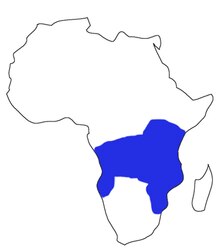| Southern giant pouched rat | |
|---|---|
| Conservation status | |
 Least Concern (IUCN 3.1) | |
| Scientific classification | |
| Domain: | Eukaryota |
| Kingdom: | Animalia |
| Phylum: | Chordata |
| Class: | Mammalia |
| Order: | Rodentia |
| Family: | Nesomyidae |
| Genus: | Cricetomys |
| Species: | C. ansorgei |
| Binomial name | |
| Cricetomys ansorgei Thomas, 1904 | |

| |
| Synonyms | |
|
See text | |
The southern giant pouched rat (Cricetomys ansorgei) is a species of rodent in the family Nesomyidae. It is distributed in the savannah of East and Southern Africa.
Synonyms
A large number of synonyms have been noted for this species. They include:
- Cricetomys adventor Thomas and Wroughton, 1907
- Cricetomys cosensi Hinton, 1919
- Cricetomys cunctator Thomas and Wroughton, 1908
- Cricetomys elgonis Thomas, 1910
- Cricetomys enguvi Heller, 1912
- Cricetomys haagneri Roberts, 1926
- Cricetomys kenyensis Osgood, 1910
- Cricetomys luteus Dollman, 1911
- Cricetomys microtis Lönnberg, 1917
- Cricetomys osgoodi Heller, 1912
- Cricetomys raineyi Heller, 1912
- Cricetomys selindensis Roberts, 1946
- Cricetomys vaughanjonesi St. Leger, 1937
- Cricetomys viator Thomas, 1904
Distribution
The southern giant pouched rat is widely distributed in mainly tropical regions of southern Africa, notably Zimbabwe, Kenya, Tanzania, Zambia, and the Democratic Republic of Congo.
Description
The southern giant pouched rat is a large rodent, with males larger than females. Adult males typically weigh 1.5 to 2.0 kg (3.3 to 4.4 lb), while females weigh 1.2 to 1.6 kg (2.6 to 3.5 lb). The pouches for which these rats are named consist of oversized cheek-pouches. These oversized cheek pouches are often used to transport large food-finds back to their burrows for storage. From their nose to the tip of their tail, these animals are approximately 70 to 80 cm (28 to 31 in) long. They have dark brown to reddish fur on their backs and a pale belly. The tail is bi-colored, brown with white at the distal third of the tail.
Females have small litters, usually between 1–3 young at a time. Males scent mark using cheek and anogenital rubbing, as well as urine, and appear to preferentially mark unfamiliar locations.
Taxonomy
An analysis of cranial head measurements, as well as mitochondrial cytochrome b phylogeny shows C. ansorgei to be distinct from other members of the genus Cricetomys. C. ansorgei may have a largely-undescribed sister species that resides west of the Congo River. Previously, many animals described as Cricetomys gambianus may have instead been C. ansorgei based on this new characterization.
Use by humans
The southern African giant pouched rat is used in tuberculosis detection and in locating landmines through initiatives by APOPO. It is also popular as bushmeat.
References
- Dando, T.; Kennerley, R. (2019). "Cricetomys ansorgei". The IUCN Red List of Threatened Species. 2019: e.T112256552A112256556. doi:10.2305/IUCN.UK.2019-1.RLTS.T112256552A112256556.en.
- Mammals of Tanzania Archived 2009-03-17 at the Wayback Machine. Fieldmuseum.org. Retrieved on 2012-12-28.
- Bo Beolens; Michael Watkins; Michael Grayson (2009). The Eponym Dictionary of Mammals. JHU Press. pp. 14–15. ISBN 978-0-8018-9304-9.
- Myers, P., R. Espinosa, C. S. Parr, T. Jones, G. S. Hammond, and T. A. Dewey. (2012). Cricetomys ansorgeisouthern giant pouched rat. The Animal Diversity Web (online).
- Don E. Wilson; DeeAnn M. Reeder (2005). Mammal Species of the World: A Taxonomic and Geographic Reference. JHU Press. pp. 932–. ISBN 978-0-8018-8221-0.
- Cricetomys ansorgei. ION: Index to Organism Names. Organismnames.com. Retrieved on 2012-12-28.
- ^ Cricetomys ansorgei . Mammal Species of the World . Bucknell.edu. Retrieved on 2012-12-28.
- African Rodentia ›› Cricetomys ansorgei [RMCA 96.036-M-5379]. Projects.biodiversity.be. Retrieved on 2012-12-28.
- Amy Rodriguez, ed. (25 May 2020). "African pouched rat". Britannica.com. Retrieved 22 May 2022.
- Freeman, Angela R.; Ophir, Alexander G. (2018-12-05). "Scent-marking behavior of the southern giant pouched rat (Cricetomys ansorgei)". Journal of Mammalogy. 99 (6): 1430–1435. doi:10.1093/jmammal/gyy137.
- ^ Olayemi, Ayodeji; Nicolas, Violaine; Hulsemans, Jan; Missoup, Alain D.; Fichet-Calvet, Elisabeth; Amundala, Drazo; Dudu, Akaibe; Dierckx, Theo; Wendelen, Wim (2012-06-26). "Taxonomy of the African giant pouched rats (Nesomyidae: Cricetomys): molecular and craniometric evidence support an unexpected high species diversity". Zoological Journal of the Linnean Society. 165 (3): 700–719. doi:10.1111/j.1096-3642.2012.00823.x. ISSN 0024-4082.
- ^ Poling, Alan (2016). "Using pouched rats to help people: Notes from the field". American Psychologist. 71 (8): 835–842. doi:10.1037/amp0000046. ISSN 1935-990X. PMID 27977280.
- Edwards, Timothy L.; Ellis, Haylee; Watkins, Erin E.; Mulder, Christiaan; Mgode, Georgies; Cox, Christophe; Poling, Alan (2017-05-26). "Tuberculosis detection by pouched rats: Opportunities for reinforcement under low-prevalence conditions". Behavioural Processes. 155: 2–7. doi:10.1016/j.beproc.2017.05.015. ISSN 0376-6357. PMID 28554740. S2CID 205981149.
Further reading
- Kingdon, J. 1984. East African mammals: An atlas of evolution in Africa. (Hares and Rodents). University of Chicago Press, Chicago, 2B:550–554.
- Kingdon, J. 1997. The Kingdon field guide to African mammals, AP Natural World Academic Press, Harcourt Brace & Company, San Diego, p. 199-200.
- Nowak, R. M. 1999. Walker's Mammals of the World. Sixth ed. Johns Hopkins University Press, Baltimore, 2:1344–1346, 1495–1496.
- Swynnerton, G. H., and R. W. Hayman. 1951. A checklist of the land mammals of the Tanganyika Territory and the Zanzibar Protectorate. Journal of the East African Natural History Society, 20(6):274–392.
| Taxon identifiers | |
|---|---|
| Cricetomys ansorgei | |
This Muroid rodent article is a stub. You can help Misplaced Pages by expanding it. |